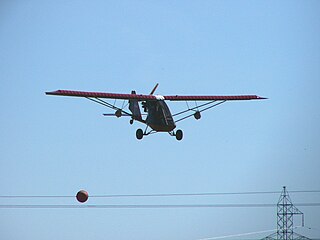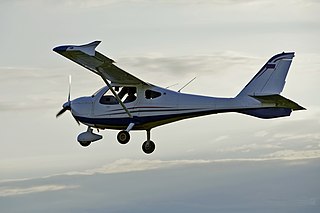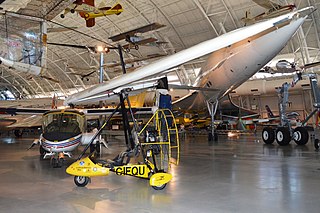Related Research Articles
A circular wing is a disc-shaped wing having the outer planform of a circle.

The Ace Baby Ace, a single-seat, single-engine, parasol wing, fixed-gear light airplane, was marketed as a homebuilt aircraft when its plans were first offered for sale in 1929 — one of the first homebuilt aircraft plans available in the United States. Plans are still available and Baby Aces are still being built. Orland Corben designed a series of aircraft for the Ace Aircraft Manufacturing Company, the Baby Ace, Junior Ace, and Super Ace. Corben's name was associated with the aircraft, and it is commonly known as the Corben Baby Ace.

The PZL-101 Gawron (rook) is a Polish agricultural and utility aircraft designed and built by WSK-Okęcie.

The Tecnam P92 Echo and Tecnam P92 Eaglet are Italian high-winged, light aircraft, designed by Luigi Pascale and built by Tecnam of Naples.

The Cessna Airmaster, is a family of single-engined aircraft manufactured by the Cessna Aircraft Company. The Airmaster played an important role in the revitalization of Cessna in the 1930s after the crash of the aviation industry during the Great Depression.

The MAI-223 Kityonok is a single-engine STOL ultralight aircraft developed by the Moscow Aviation Institute's special design bureau (OSKBEC) from 2002. The first production aircraft was delivered in 2008. A crop spraying version is under development. The aircraft is supplied as a kit for amateur construction or complete and ready-to-fly.

The Birdman Chinook is a family of single and two-place, pusher configuration, high-wing ultralight aircraft that was first flown on 12 December 1982 and produced by Birdman Enterprises of Edmonton, Alberta, Canada, starting in 1983.

The Ryan YO-51 Dragonfly was an observation aircraft designed and built by Ryan Aeronautical for the United States Army Air Corps (USAAC). A single-engined parasol wing monoplane, it was designed for optimum STOL capability, but although three prototypes proved highly successful in testing, the Stinson YO-49 was judged superior and no production contract was placed.

The PWS-11 was a Polish aerobatic and trainer aircraft, developed in 1928-1929 by PWS, which remained a prototype.
The Loehle Sport Parasol is an American single-seat, parasol winged, single engine, ultralight aircraft produced in kit form by Loehle Aircraft for amateur construction. The aircraft meets the requirements of the US FAR 103 Ultralight Vehicles regulations.

The Flight Design MC is a German light-sport aircraft, designed and produced by Flight Design, introduced at AirVenture in 2008. The aircraft is supplied as a complete ready-to-fly-aircraft.

The Aerotique Parasol is an American parasol-wing, strut-braced, conventional landing gear, single-seat, open cockpit, single engine in tractor configuration, ultralight aircraft that was designed as an ultralight version of the 1926 vintage Heath Parasol. It was originally produced by Yesteryear Aviation and later by Aerotique Aviation. The aircraft was supplied as factory-built only.

The Ritz Model A is an American ultralight aircraft that was designed by Gerry Ritz in 1984 and supplied in the form of plans for amateur construction.

The Paramount Cabinaire was a 1920s designed cabin biplane, designed by Walter J. Carr and produced by the Paramount Aircraft Corporation. Only eight were completed before production ceased.

The Cosmos Phase II and Phase III are a series of French two-seat flying wing ultralight trikes that were produced by Cosmos ULM of Fontaine-lès-Dijon and now by Cosmos Ultralight of Puente de Ixtla, Mexico. The aircraft are supplied as factory completed aircraft and are not available as kits.

The Vulcan American Moth Monoplane was an early parasol-wing monoplane developed by the Doyle brothers.

The Microleve Corsario is a Brazilian amphibious ultralight flying boat that was designed and produced by Microleve of Rio de Janeiro. The aircraft was supplied as a kit for amateur construction.
The St Croix Pietenpol Aerial is an American homebuilt aircraft that was designed by Chad and Charles Willie and produced by St Croix Aircraft of Corning, Iowa, first flown in 1977. When it was available the aircraft was supplied in the form of plans for amateur construction, with partial kits available.
The Bilsam Sky Walker II is a Polish powered parachute designed and produced by Bilsam Aviation of Poznań. The aircraft is supplied as a complete ready-to-fly-aircraft.
The Gabriel P 6 was a Polish training aircraft and the P 7 a tourer. The difference between them was the wing configuration, chosen to optimise their speed range for their role, so the P 6 was a biplane and the P 7 a parasol wing aircraft.
References
- ↑ "Nemeth Parasol: Strange Aircraft that Flew". 10 June 2015. Retrieved 15 August 2023.
- ↑ "The Nemeth circular wing plane tested". June 1934. Retrieved 15 August 2023.
- ↑ "Forgotten Aircraft, The Nemeth Parasol – A Parachuting Plane". 2 May 2022. Retrieved 15 August 2023.